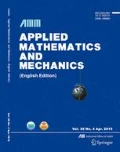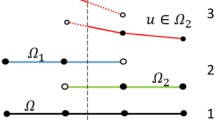Abstract
Based on the newly-developed element energy projection (EEP) method for computation of super-convergent results in one-dimensional finite element method (FEM), the task of self-adaptive FEM analysis was converted into the task of adaptive piecewise polynomial interpolation. As a result, a satisfactory FEM mesh can be obtained, and further FEM analysis on this mesh would immediately produce an FEM solution which usually satisfies the user specified error tolerance. Even though the error tolerance was not completely satisfied, one or two steps of further local refinements would be sufficient. This strategy was found to be very simple, rapid, cheap and efficient. Taking the elliptical ordinary differential equation of second order as the model problem, the fundamental idea, implementation strategy and detailed algorithm are described. Representative numerical examples are given to show the effectiveness and reliability of the proposed approach.
Similar content being viewed by others
References
Babuska I, Rheinboldt W C. A posteriori error analysis of finite element method for one-dimensional problems [J]. SIAM Journal on Numerical Analysis, 1981, 18(3): 565–589.
Zienkiewicz O C, Zhu J Z. The superconvergence patch recovery (SPR) and a posteriori error estimates, part 1: the recovery technique [J]. Int J Num Meth Engng, 1992, 33(7): 1331–1364.
Zienkiewicz O C, Zhu J Z. The superconvergence patch recovery (SPR) and a posteriori error estimates, part 2: error estimates and adaptivity [J]. Int J Num Meth Engng, 1992, 33(7):1365–1382.
Lin Qun, Zhu Qiding. Theory of Pre-and Post-Processing of FEM[M]. Shanghai Science and Technology Press, Shanghai, 1994 (in Chinese).
Chen Chuanmiao. Constructive Theory of Super-convergence in FEM[M]. Hunan Science and Technology Press, Changsha, 2002 (in Chinese).
Ascher U, Christiansen J, Russell R D. Algorithm 569, COLSYS: Collocation software for boundary value ODEs[J]. ACM Trans Math Software, 1981, 7(2): 223–229.
Yuan Si. The Finite Element Method of Lines[M]. Science Press, Beijing-New York, 1993.
Yuan Si, Wang Mei, Lin Yongjing, Yuan Zheng. New thoughts in super-convergent computation of stresses in FEM(OL)[J]. Engineering Mechanics (Suppl Issue), Changsha, 2002, 112–118 (in Chinese).
Yuan Si, Wang Mei. An element-energy-projection method for post-computation of super-convergent solutions in one-dimensional FEM [J]. Engineering Mechanics, 2004, 21(2): 1–9 (in Chinese).
Strang G, Fix G. An Analysis of the Finite Element Method[M]. Prentice-Hall, London, 1973.
Douglas J, Dupont T. Galerkin approximations for the two point boundary problems using continuous piecewise polynomial spaces[J]. Numer Math, 1974, 22(2): 99–109.
Author information
Authors and Affiliations
Corresponding author
Additional information
Communicated by LONG Yu-qiu
Project supported by the National Natural Science Foundation of China (No.50278046)
Rights and permissions
About this article
Cite this article
Yuan, S., He, Xf. Self-adaptive strategy for one-dimensional finite element method based on element energy projection method. Appl Math Mech 27, 1461–1474 (2006). https://doi.org/10.1007/s10483-006-1103-1
Received:
Revised:
Issue Date:
DOI: https://doi.org/10.1007/s10483-006-1103-1
Key words
- finite element method (FEM)
- self-adaptive solution
- super-convergence
- element energy projection
- ordinary differential equation (ODE)



